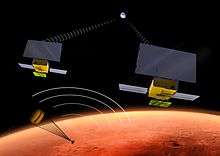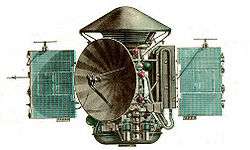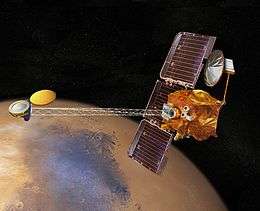InSight
  Top: Artist's rendering of the MarCO CubeSats Bottom: Artist's rendering of the InSight lander | |||||||||
| Names |
Interior Exploration using Seismic Investigations, Geodesy and Heat Transport Geophysical Monitoring Station | ||||||||
|---|---|---|---|---|---|---|---|---|---|
| Mission type | Mars lander | ||||||||
| Operator | NASA / JPL | ||||||||
| Website |
insight | ||||||||
| Mission duration | Planned: 2 years[1] | ||||||||
| Spacecraft properties | |||||||||
| Manufacturer | Lockheed Martin Space Systems | ||||||||
| Launch mass | 360 kg (794 lb)[2] | ||||||||
| Dimensions | Deployed: 6.1 × 2.0 × 1.4 m (20 × 6.5 × 4.5 ft)[2] | ||||||||
| Power | 450 W, solar / Li-ion battery | ||||||||
| Start of mission | |||||||||
| Launch date | 5 May 2018[3] | ||||||||
| Rocket | Atlas V 401[4] | ||||||||
| Launch site | Vandenberg AFB, California, U.S.[4] | ||||||||
| Contractor | United Launch Alliance | ||||||||
| Mars lander | |||||||||
| Landing date | 26 November 2018[5] | ||||||||
| Landing site |
Elysium Planitia[6][7] 4°N 136°E / 4°N 136°E | ||||||||
| |||||||||
|
| |||||||||
InSight is a robotic Mars lander manufactured in the 2010s which was originally planned for launch in March 2016.[8] The name is a backronym for Interior Exploration using Seismic Investigations, Geodesy and Heat Transport.[1] Due to the failure of its SEIS instrument prior to launch, NASA announced in December 2015 that the mission had been postponed, and in March 2016, launch was rescheduled for 5 May 2018.
The mission's objective is to place a stationary lander equipped with a seismometer and heat transfer probe on the surface of Mars to study its early geological evolution. This would bring new understanding of the Solar System's terrestrial planets — Mercury, Venus, Earth, Mars — and Earth’s Moon. By reusing technology from the Mars Phoenix lander, which successfully landed on Mars in 2008, it is expected that the cost and risk will be reduced.[1]
Following a persistent vacuum failure in the main scientific instrument, the launch window was missed, and the InSight spacecraft was returned to Lockheed Martin's factory in Colorado. NASA officials decided in March 2016 to spend an estimated US$150 million to delay launch of InSight to May 2018.[3]
History
InSight was initially known as GEMS (Geophysical Monitoring Station), but its name was changed in early 2012 at the request of NASA.[9] Out of 28 proposals from 2010,[10] it was one of the three Discovery Program finalists receiving US$3 million in May 2011 to develop a detailed concept study.[11] In August 2012, InSight was selected for development and launch.[8] Managed by NASA’s Jet Propulsion Laboratory (JPL) with participation from scientists from several countries, the mission is cost-capped at US$425 million, not including launch vehicle funding.[12]
NASA began construction of the lander on 19 May 2014,[13] with general testing starting in 27 May 2015.[14]
A persistent vacuum leak in the French seismometer known as the Seismic Experiment for Interior Structure (SEIS) led NASA to postpone the planned launch in March 2016 to May 2018. NASA's Jet Propulsion Laboratory will take over development of the vacuum container for SEIS, with France's space agency, CNES, handling instrument integration and test activities.[15]
Status
The InSight spacecraft has been returned to Lockheed Martin's factory in Colorado for storage, and the Atlas V rocket intended to launch the spacecraft has been reassigned to the WorldView-4 mission.[16]
NASA officials announced on 9 March 2016 that InSight is not planned for cancellation, but would instead be delayed until the 2018 launch window at an estimated cost of US$150 million.[3][5] The spacecraft is scheduled to launch on 5 May 2018 for a Mars landing on 26 November; the flight plan remains unchanged, and launch will take place aboard an Atlas V rocket from Vandenberg Air Force Base.[3][5] NASA's Jet Propulsion Laboratory has been tasked with redesigning and building a new vacuum enclosure for the SEIS instrument, while CNES will conduct instrument integration and testing.[15][17]
Objectives
InSight will place a single stationary lander on Mars to study its deep interior and address a fundamental issue of planetary and Solar System science: understanding the processes that shaped the rocky planets of the inner Solar System (including Earth) more than four billion years ago.[18]
_-_Artist's_Concept.jpg)
InSight's primary objective is to study the earliest evolutionary history of the processes that shaped Mars. By studying the size, thickness, density and overall structure of Mars' core, mantle and crust, as well as the rate at which heat escapes from the planet's interior, InSight will provide a glimpse into the evolutionary processes of all of the rocky planets in the inner Solar System.[18] The rocky inner planets share a common ancestry that begins with a process called accretion. As the body increases in size, its interior heats up and evolves to become a terrestrial planet, containing a core, mantle and crust.[19] Despite this common ancestry, each of the terrestrial planets is later shaped and molded through a poorly understood process called differentiation. InSight mission's goal is to improve understanding of this process and, by extension, terrestrial evolution, by measuring the planetary building blocks shaped by differentiation: a terrestrial planet's core, mantle and crust.[19]
The mission will determine if there is any seismic activity, measure the amount of heat flow from the interior, estimate the size of Mars' core and whether the core is liquid or solid.[20] This data would be the first of its kind on Mars.[21] The mission's secondary objective is to conduct an in-depth study of geophysics, tectonic activity and the effect of meteorite impacts on Mars, which could provide knowledge about such processes on Earth. Crust thickness, mantle velocity, core radius and density, and seismic activity should experience a measured accuracy increase on the order 3X to 10X compared to current data.[21]
In terms of fundamental processes shaping planetary formation, Mars contains the most in-depth and accurate historical record, because it is big enough to have undergone the earliest accretion and internal heating processes that shaped the terrestrial planets, but small enough to have retained signs of those processes.[18]
Design

The mission further develops design heritage from the 2008 Phoenix Mars Lander.[22] Because InSight is planned to be powered by a photovoltaic system, it would land near the equator to enable a projected lifetime of 2 years (or 1 Mars year).[1]
Specifications
- Mass
- 360 kg (794 lb)[2]
- Dimensions
- About 6.1 m (20 ft) wide with solar panels deployed. The science deck is about 2.0 m (6.5 ft) deep and 1.4 m (4.5 ft) high.[2]
- Power
- Power is generated by two round photovoltaic arrays, each 2.15 m (7.1 ft) in diameter and consisting of SolAero ZTJ triple-junction solar cells made of InGaP/InGaAs/Ge arranged on Orbital ATK UltraFlex arrays. After touchdown on the Martian surface, the arrays are deployed by opening up like a folding fan.[23][24]
- CubeSats
- The Mars Cube One (MarCO) spacecraft, a set of two 6U CubeSats, will piggyback with the InSight mission to help relay communications during the probe's entry, descent and landing phase.[25][26] The two 6U CubeSats, named "MarCO" A and B, are identical.[27] They measure 30 cm × 20 cm × 10 cm (11.8 in × 7.9 in × 3.9 in) and will fly as a pair for redundancy. They will fly by Mars during the entry, descent and landing (EDL) phase of the InSight mission and relay InSight's telemetry in real time.[28][29] MarCO is a technology capability demonstration of communications relay system.
|
Scientific payload
InSight's science payload will consist of two main instruments:
- The Seismic Experiment for Interior Structure (SEIS) will take precise measurements of quakes and other internal activity on Mars to better understand the planet's history and structure. It will also investigate how the Martian crust and mantle respond to the effects of meteorite impacts, which gives clues to the planet's inner structure.[30][31][32] SEIS is provided by the French Space Agency (CNES), with the participation of the Institut de Physique du Globe de Paris (IPGP), the Swiss Federal Institute of Technology (ETH), the Max Planck Institute for Solar System Research (MPS), Imperial College, Institut supérieur de l'aéronautique et de l'espace (ISAE) and JPL.[33][34] The seismometer is a sensitive broad-band instrument designed to detect sources including atmospheric excitation and tidal forces from Phobos.[35] SEIS was found to have a vacuum leak which could not be corrected in time for the launch of InSight, forcing a two year mission postponement.[15]
- The Heat Flow and Physical Properties Package (HP3) instrument, provided by the German Space Agency (DLR), is a self-penetrating heat flow probe —nicknamed "the mole".[35][22][36][37] Also called a "self-hammering nail", it is being designed to burrow up to 5 m (16 ft) below the surface to measure how much heat is coming from Mars' core, and thus help reveal the planet's thermal history.[35][22][36][37] It trails a tether containing precise temperature sensors every 10 cm (3.9 in) to measure the temperature profile of the subsurface.[35][38]

- Additionally, the Rotation and Interior Structure Experiment (RISE) led by the Jet Propulsion Laboratory (JPL), will use the lander's X-band radio to provide precise measurements of planetary rotation to better understand the inside of Mars.[39] X-band radio tracking, capable of an accuracy under 2 cm, will build on previous Viking program and Mars Pathfinder data.[35] The previous data sets allowed the core size to be constrained, but with a third data set from InSight, the nutation amplitude can be determined.[35] Once spin axis direction, precession, and nutation amplitudes are better understood, it should be possible to calculate the size and density of the Martian core and mantle.[35] This would increase the understanding on the formation of terrestrial planets (e.g. Earth) and rocky exoplanets.[35]
- Wind and temperature sensors, as well as a high-resolution (10 mPa) pressure sensor from Spain's Centro de Astrobiología will monitor weather at the landing site.[21][40]
- A magnetometer will measure magnetic disturbances caused by the Martian ionosphere.[40]
A camera mounted on the lander's arm can capture black and white images of the instruments on the lander's deck and a 3-D view of the ground where the seismometer and heat flow probe will be placed. It will then be used to help engineers and scientists guide the deployment of the instruments to the ground. With a 45-degree field of view, the camera will also provide a panoramic view of the terrain surrounding the landing site.[41] A second similar camera, with a wide-angle 120-degree field of view lens will be mounted under the edge of the lander's deck and will provide a complementary view of the instrument deployment area.[41]
A color camera was also considered if certain criteria such as the project meeting development deadlines and budgeted funding, but this failed to materialize.[21][42] An electromagnetic sounder to provide data on crustal thickness, ground water, and on the mantle lithosphere was considered as well.[43] Technology to clean dust off the solar panels was considered for Mars Exploration Rover's development.[44] In the years since their development others have proposed ways of cleaning off panels.[45] The effects of Martian surface dust on solar cells was studied in the 1990s by the Materials Adherence Experiment on Mars Pathfinder.[46][47][48] InSight may represent possible piggy-back opportunity for MetNet.[49] It may also be a chance to capitalize on previously funded technology development such as the Urey Mars Organic and Oxidant Detector and Mars Organic Molecule Analyzer.[50]
Launch
The launch is being managed by NASA's Launch Services Program. Originally scheduled for 4 March 2016 on an Atlas V 401 (4 meter fairing/zero (0) solid rocket boosters/single (1) engine Centaur) from Vandenberg Air Force Base in California, USA.[51] This would have been the first American interplanetary mission to launch from California.[51] On 22 December 2015, NASA called off the launch of InSight in March 2016 due to the inability of the SEIS instrument to hold a protective vacuum under simulated Martian conditions.[52][53][54]
Planned landing site


As InSight's science goals are not related to any particular surface feature of Mars, potential landing sites were chosen on the basis of practicality. Candidate sites needed to be near the equator of Mars to provide sufficient sunlight for the solar panels year round, have a low elevation to allow for sufficient atmospheric braking during EDL, flat, relatively rock-free to reduce the probability of complications during landing, and soft enough terrain to allow the heat flow probe to penetrate well into the ground. An optimal area that meets all these requirements is Elysium Planitia, so all 22 initial potential landing sites were located in this area.[55] The only two other areas on the equator and at low elevation, Isidis Planitia and Valles Marineris, are too rocky. In addition, Valles Marineris has too steep a gradient to allow safe landing.[6]
In September 2013, the initial 22 potential landing sites were narrowed to 4, the Mars Reconnaissance Orbiter will then be used to gain more information on each of the 4 potential sites before a final decision is made.[6][56] Each site consists of a landing ellipse that measures about 130 km (81 miles) long by 27 km (17 miles) wide.[57]
Team and participation
The InSight science and engineering team includes scientists and engineers from many disciplines, countries and organizations. The science team assigned to InSight includes scientists from institutions in the U.S., France, Germany, Austria, Belgium, Canada, Japan, Switzerland, Spain and the United Kingdom.[58]
Mars Exploration Rover project scientist W. Bruce Banerdt is the principal investigator for the InSight mission and the lead scientist for the SEIS instrument.[59] Suzanne Smrekar, whose research focuses on the thermal evolution of planets and who has done extensive testing and development on instruments designed to measure the thermal properties and heat flow on other planets,[60] is the lead for InSight's HP3 instrument. Sami Asmar, an expert in advanced studies using radio waves,[61] is the lead for InSight's RISE investigation. The InSight mission team also includes project manager Tom Hoffman and deputy project manager Henry Stone.[58]
See also
References
- 1 2 3 4 "InSight - Mission Overview". NASA. 2012. Retrieved 22 August 2012.
- 1 2 3 4 "InSight Lithograph" (PDF). NASA. July 2015. LG-2015-07-072-HQ.
- 1 2 3 4 Clark, Stephen (9 March 2016). "InSight Mars lander escapes cancellation, aims for 2018 launch". Spaceflight Now. Retrieved 9 March 2016.
- 1 2 Clark, Stephen (19 December 2013). "Mars lander to launch from California on Atlas 5 in 2016". Spaceflight Now. Retrieved 20 December 2013.
- 1 2 3 Chang, Kenneth (9 March 2016). "NASA Reschedules Mars InSight Mission for May 2018". The New York Times. Retrieved 9 March 2016.
- 1 2 3 "NASA Evaluates Four Candidate Sites for 2016 Mars Mission". NASA. 4 September 2013. Retrieved 4 September 2013.
- ↑ "Single Site on Mars Advanced for 2016 NASA Lander". NASA. 4 March 2015. Retrieved 16 December 2015.
- 1 2 Vastag, Brian (20 August 2012). "NASA will send robot drill to Mars in 2016". The Washington Post.
- ↑ Wells, Jason (28 February 2012). "JPL changes name of Mars mission proposal". Times Community News via Los Angeles Times. Retrieved 25 September 2016.
- ↑ "New NASA Mission To take First Look Deep Inside Mars". NASA. 20 August 2012.
- ↑ "NASA Selects Investigations For Future Key Planetary Mission". NASA. 5 May 2011. Retrieved 6 May 2011.
- ↑ Taylor, Kate (9 May 2011). "NASA picks project shortlist for next Discovery mission". TG Daily. Retrieved 20 May 2011.
- ↑ Webster, Guy; Brown, Dwayne; Napier, Gary (19 May 2014). "Construction to Begin on 2016 NASA Mars Lander". NASA. Retrieved 20 May 2014.
- ↑ Webster, Guy; Brown, Dwayne (27 May 2015). "NASA Begins Testing Mars Lander for Next Mission to Red Planet". NASA. Retrieved 28 May 2015.
- 1 2 3 Foust, Jeff (28 March 2016). "InSight's second chance". The Space Review. Retrieved 2016-04-05.
- ↑ Clark, Stephen (5 March 2016). "Fate of NASA's InSight Mars mission to be decided soon". Spaceflight Now. Retrieved 9 March 2016.
- ↑ "NASA Targets May 2018 Launch of Mars InSight Mission". NASA. 9 March 2016. Retrieved 9 March 2016.
- 1 2 3 "InSight: Mission". NASA / Jet Propulsion Laboratory. Retrieved 2 December 2011.
- 1 2 "InSight: Science". NASA / Jet Propulsion Laboratory. Retrieved 2 December 2011.
- ↑ Kremer, Ken (2 March 2012). "NASAs Proposed 'InSight' Lander would Peer to the Center of Mars in 2016". Universe Today. Retrieved 27 March 2012.
- 1 2 3 4 Banerdt, W. Bruce (2013). InSight Project Status (PDF). 28th Mars Exploration Program Analysis Group Meeting. 23 July 2013. Virtual meeting.
- 1 2 3 Agle, D. C. (20 August 2012). "New Insight on Mars Expected From new NASA Mission". NASA.
- ↑ "SolAero Awarded Solar Panel Manufacturing Contract by ATK for NASA's InSight Mars Lander Mission" (Press release). SolAero. 26 February 2014. Retrieved 13 June 2015.
- ↑ "UltraFlex Solar Array Systems" (PDF). Orbital ATK. Retrieved 13 June 2015.
- ↑ Wall, Mike (12 May 2015). "NASA Wants New Rocket Rides for Tiny CubeSats". Space.com. Retrieved 2015-05-13.
- ↑ Dean, James (16 May 2015). "NASA seeks launchers for smallest satellites". Florida Today. Retrieved 2015-05-16.
- ↑ Schulze-Makuch, Dirk (9 June 2015). "CubeSats to the Rescue?". Smithsonian Air & Space. Retrieved 2015-06-09.
- ↑ Messier, Douglas (27 May 2015). "Two Tiny 'CubeSats' Will Watch 2016 Mars Landing". Space.com. Retrieved 2015-05-27.
- ↑ Asmar, Sami; Matousek, Steve (20 November 2014). Mars Cube One (MarCO) - The First Planetary CubeSat Mission (PDF). NASA / Jet Propulsion Laboratory. Retrieved 2015-05-27.
- ↑ "NASA and French Space Agency Sign Agreement for Mars Mission" (Press release). NASA. 10 February 2014. Retrieved 11 February 2014.
- ↑ Boyle, Rebecca (4 June 2015). "Listening to meteorites hitting Mars will tell us what's inside". New Scientist. Retrieved 2015-06-05.
- ↑ Kumar, Sunil (1 September 2006). Design and development of a silicon micro-seismometer (PDF) (Ph.D.). Imperial College London. Retrieved 2015-07-15.
- ↑ Francis, Matthew (21 August 2012). "New probe to provide InSight into Mars' interior". Ars Technica. Retrieved 21 August 2012.
- ↑ Lognonné, P.; Banerdt, W. B.; Giardini, D.; Christensen, U.; Pike, T.; et al. (October 2011). The GEMS (GEophysical Monitoring Station) SEISmometer (PDF). EPSC-DPS Joint Meeting 2011. 2-7 October 2011. Nantes, France. Bibcode:2011epsc.conf.1507L. EPSC-DPS2011-1507-1.
- 1 2 3 4 5 6 7 8 Banerdt, W. Bruce (2012). InSight - Geophysical Mission to Mars (PDF). 26th Mars Exploration Program Analysis Group Meeting. 4 October 2012. Monrovia, California.
- 1 2 Grott, M.; Spohn, T.; Banerdt, W. B.; Smrekar, S.; Hudson, T. L.; et al. (October 2011). Measuring Heat Flow on Mars: The Heat Flow and Physical Properties Package on GEMS (PDF). EPSC-DPS Joint Meeting 2011. 2-7 October 2011. Nantes, France. Bibcode:2011epsc.conf..379G. EPSC-DPS2011-379-1.
- 1 2 Kelly, Tiffany (22 May 2013). "JPL begins work on two new missions to Mars". Glendale News-Press. Retrieved 24 August 2015.
- ↑ "HP3 (Heat Flow and Physical Properties Probe)". NASA. Retrieved 24 August 2015.
- ↑ Dehant, V.; Folkner, W.; Le Maistre, S.; Rosenblatt, P.; Yseboodt, M.; et al. (October 2011). Geodesy on GEMS (GEophysical Monitoring Station) (PDF). EPSC-DPS Joint Meeting 2011. 2-7 October 2011. Nantes, France. Bibcode:2011epsc.conf.1551D. EPSC-DPS2011-1551.
- 1 2 David, Leonard (August 15, 2014). "NASA's Next Mars Lander Will Peer Deep Into Red Planet's History: Here's How". Space.com. Retrieved 2014-08-16.
- 1 2 "InSight - Technology". NASA / Jet Propulsion Laboratory. 2012. Retrieved 20 August 2012.
- ↑ Golombek, Matt; Banerdt, W. Bruce (2014). InSight Project Status and Landing Site Selection (PDF). 29th Mars Exploration Program Analysis Group Meeting. 13-14 May 2014. Crystal City, Virginia.
- ↑ Banerdt, W. Bruce (2009). Geophysical Network Mission for Mars (PDF). Mars Panel Meeting 2 of the Planetary Science Decadal Survey. 4-6 November 2009. Pasadena, California.
- ↑ Spencer, Henry (17 November 2008). "Why don't the Mars rovers have dust wipers?". New Scientist.
- ↑ "Mars cleaning tech offers method to sweep dust off Earth's solar panels". The American Ceramic Society. 25 August 2010.
- ↑ Landis, G. A.; Jenkins, P. P. (1997). Dust on Mars: Materials Adherence Experiment results from Mars Pathfinder. Photovoltaic Specialists Conference. 29 September-3 October 1997. Anaheim, California. doi:10.1109/PVSC.1997.654224.
- ↑ Matijevic, J. R.; Crisp, J.; Bickler, D. B.; Banes, R. S.; Cooper, B. K.; et al. (December 1997). "Characterization of the Martian surface deposits by the Mars Pathfinder rover, Sojourner". Science. 278 (5344): 1765–1768. Bibcode:1997Sci...278.1765M. doi:10.1126/science.278.5344.1765.
- ↑ "UALR Particulate Science Research". University of Arkansas at Little Rock. 2013. Retrieved 20 February 2014.
- ↑ Harri, A.-M.; Schmidt, W.; Guerrero, H.; Vázquez, L. (April 2012). "Future Plans for MetNet Lander Mars Missions" (PDF). Geophysical Research Abstracts. 14 (EGU2012–8224). Bibcode:2012EGUGA..14.8224H.
- ↑ "NASA Selects Proposals for Future Mars Missions and Studies". NASA. 10 January 2006.
- 1 2 "NASA Awards Launch Services Contract for InSight Mission". NASA. 19 December 2013. Retrieved 11 January 2014.
- ↑ "NASA calls off next Mars mission because of instrument leak". Excite News. Associated Press. 22 December 2015. Retrieved 22 December 2015.
- ↑ Chang, Kenneth (22 December 2015). "Leaks in Instrument Force NASA to Delay Mars Mission Until 2018". The New York Times. Retrieved 22 December 2015.
- ↑ Brown, Dwayne; Cantillo, Laurie; Webster, Guy; Watelet, Julien (22 December 2015). "NASA Suspends 2016 Launch of InSight Mission to Mars". NASA. Retrieved 23 December 2015.
- ↑ Vergano, Dan (4 September 2013). "NASA searches for (literally) boring Mars landing site". USA Today. Retrieved 5 September 2013.
- ↑ Boyle, Alan (5 March 2015). "NASA Picks Prime Target for 2016 InSight Mars Lander". NBC News. Retrieved 5 March 2015.
- ↑ Wall, Mike (March 11, 2015). "NASA Eyeing Landing Site for 2016 Mars Mission". Space.com. Retrieved 2015-03-11.
- 1 2 "InSight: People". NASA / Jet Propulsion Laboratory. Retrieved 2 December 2011.
- ↑ "JPL Science: People - Bruce Banerdt". NASA / Jet Propulsion Laboratory. Retrieved 2 December 2011.
- ↑ "JPL Sciences: People - Sue Smrekar". NASA / Jet Propulsion Laboratory. Retrieved 2 December 2011.
- ↑ "JPL Science and Technology: Sami Asmar". NASA / Jet Propulsion Laboratory. Archived from the original on 15 April 2012.
External links
| Wikimedia Commons has media related to InSight. |
.png)





.jpg)
.jpg)
